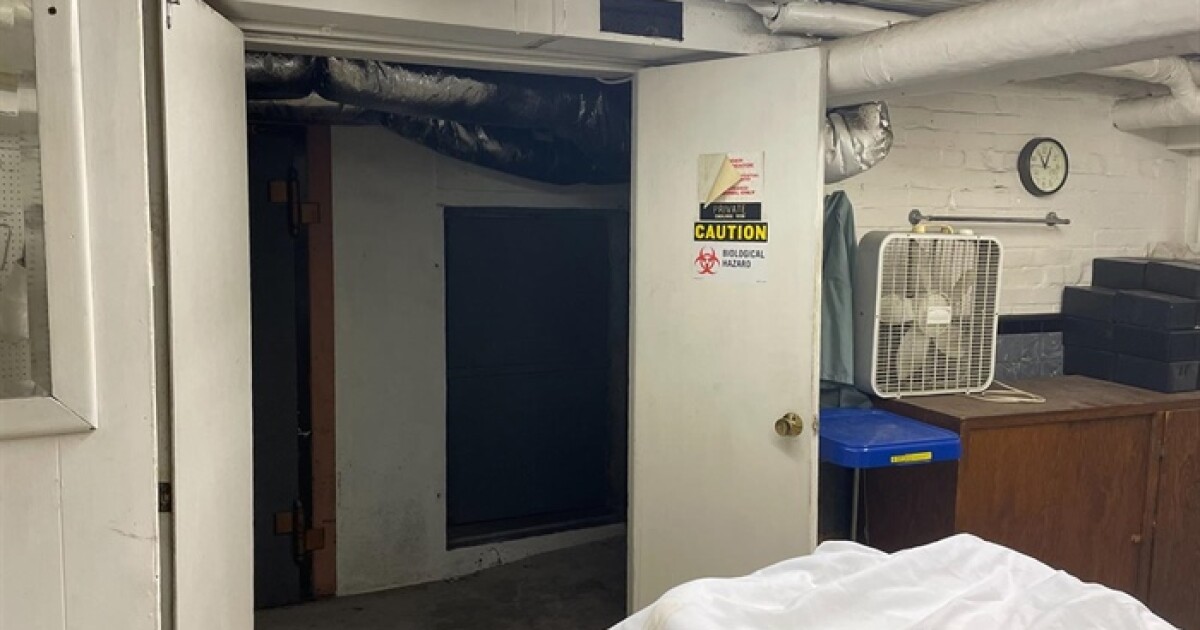Business
A Belleville duplex is falling apart after neglect and squatter
Editor’s note: This story was originally published in the Belleville News-Democrat.Half of a west Belleville duplex that’s falling into disrepair has become a headache for city officials, police, neighbors and an alderwoman who is “frustrated beyond belief.”The man who owned and lived in the unit died five years ago, apparently with no will. Since that time, it’s been tied up in bureaucracy with a reverse-mortgage lender and the U.S. Department of Housing and Urban Development (HUD), which essentially inherited the federally-insured loan and its property lien.To make matters worse, a squatter took possession early last year and refuses to leave, and police can’t force entry without a court-ordered eviction, according to city officials.The woman has removed HUD-ordered locks on doors and replaced them with her own and repeatedly signed up for utilities using fake names, said Scott Tyler, the city’s director of health, housing and building.“When I asked HUD what their next step is, they said they were going to sell it, and whoever buys it is going to be responsible for getting the squatter out of there,” he said.“I said, ‘Do you let these people know that? They’re buying a piece of property … Do they understand that there’s a squatter in there and that they have to deal with it?’ It’s crazy.”As of last week, the front window featured dueling messages, including a “No Trespassing” sign posted by the squatter and a city notice stating that the unit is “condemned as unsafe for human occupancy” due to the water being turned off. No one answered a knock on the door by a BND reporter.The other half of the duplex has a different owner who’s been renting it out, but the tenant left about a month ago, neighbors say.
Teri Maddox
/
Belleville News-DemocratShingles are falling off the roof at 7312 Foley Drive in Belleville, where half of a duplex has been vacant for five years.
Enlisting congressional helpIn January, the city and a nonprofit organization called West End Redevelopment Corp. asked for help with the problem unit at 7312 Foley Drive from U.S. Rep. Nikki Budzinski (D-13th District in Illinois). The organization even offered to buy it.According to Budzinski’s chief of staff, John Lee, her caseworkers reached out to HUD representatives, who told them that squatting is a “local law-enforcement issue” and the agency is planning to sell the loan this year to an eligible bidder as part of an “asset sale.”“The new servicer will move forward with foreclosure to get title to the property, and then they can sell it,” wrote HUD representative Kimberly Danna in an email to a Budzinski caseworker.Under Illinois law, it could take several more months for a new owner to evict the squatter.In the meantime, the unit continues to deteriorate. Shingles are falling from the roof, black mold is growing on exterior siding, paint is peeling off the garage door and trash is strewn in the yard.Ward 8 Alderwoman Kara Osthoff didn’t respond to BND requests for comment. But she expressed concern in a December 2023 email obtained through a Freedom of Information Act request.“The perception that the west end of Belleville in particular is ‘going downhill’ is something I know you have all heard from the community,” Osthoff wrote to Tyler, Mayor Patty Gregory, Police Chief Matt Eiskant, Sgt. Sam Parsons and city attorneys Garrett Hoerner and Lloyd Cueto.“I know that we have many many issues facing us, but if we don’t start addressing these things with more urgency and immediacy, I don’t know what is going to become of the aging house stock we have on this side of town.”Assistant Police Chief Mark Heffernan, spokesman for Belleville Police Department, declined to be interviewed this month about the Foley Drive unit or squatting in general.
Teri Maddox
/
Belleville News-DemocratTrash is stacked next to the front door at 7312 Foley Drive in Belleville, where a squatter installed her own door knob and dead-bolt lock.
Built in the 1980sKent Gardner, who owned and lived in the unit at 7312 Foley Drive, died in 2019 at age 87. Before retirement, the former East St. Louis resident had worked as a U.S. government energy consultant in California and elsewhere for decades, according to his obituary.St. Clair County records show Gardner bought the unit in the 1980s, when it was part of a new complex of four duplexes, also known as villas, at Foley Drive and South 74th Street. He’s still listed as the property owner.Gardner took out a $183,000 home-equity conversion mortgage in 2011, the records show. It was part of a Federal Housing Administration reverse-mortgage loan program for senior citizens who go through FHA-approved lenders.“(The program) enables you to withdraw a portion of your home’s equity to use for home maintenance, repairs, or general living expenses,” HUD’s website explains.Today, the Foley Drive unit is assessed at $44,177. That’s one-third of its market value of $132,531, although other units in the same complex have sold for significantly less in recent years.Kent Gardner’s wife, Patty, died in 2011, his obituary states. Son Scott Gardner couldn’t be reached for comment on this story. Daughter Stacey Gardner declined to comment.In 2022, Belleville resident Chris “Lumpy” Landrum took an interest in the vacant unit, thinking it would be a nice place to live and knowing the developer had a reputation for top-quality construction.The unit has a fireplace, brick facade in front, composite siding, a shake-shingle roof, wooded back yard, privacy fence and vibrant Japanese maple in front.“I was hoping to buy it in in a short sale,” Landrum said, adding that he grew up on the west end and would take better care of the property than a real-estate investor “just riding a hot market.”But Landrum said he faced hurdle after hurdle getting information from HUD. Then in early 2023, he began seeing the squatter, who moved in despite notices posted on windows by Guardian Asset Management, an agency contractor, that prohibited occupancy.The woman stayed regularly at first then left for weeks at a time, Landrum said. He described the unit’s interior as going from clean and well-maintained to dirty and full of trash. Its windows are now covered with paper.St. Clair County records show that the federal government has paid taxes on the property, but a private investor bought its delinquent-tax bill for 2022, so the party that redeems it will have to pay interest.
This drone photo shows four duplexes, also known as villas, with eight units that are part of a complex on Foley Drive in Belleville.
Different kind of squattingBelleville has had problems in the past with squatters in chronically-derelict buildings, particularly in its historic downtown. City officials have determined that many are living on the street due to drug addiction or mental illness.However, the situation at 7312 Foley Drive is different. The unit looked to be in good shape when it was first vacated, Landrum said. Reports by police and city officials obtained through the Freedom of Information Act request indicate the squatter has a vehicle and small children.“There are a lot of professional squatters out there,” Landrum said. “They just move from place to place to place and never have to pay a dime of rent or living expenses. They’re not stupid.”Tyler, the housing director, told the BND he went to the Foley Drive unit in February 2023, made contact with the squatter and notified her that she couldn’t legally live there without an occupancy permit.The woman reportedly told Tyler she was a relative and caregiver for the deceased owner and promised she would go to the housing office to get a permit the next day, which didn’t happen, according to police reports and an email from Tyler to Chief Eiskant.“Tyler then made contact with (the deceased owner’s) daughter, who said that she did not know this woman and had no idea why she was living in his house,” one police report stated.Officers went to the unit in early March to issue the woman a citation for occupancy violations and reported that she opened the door but then closed it, purportedly to call Tyler, and never came back.Around the same time, Tyler sent an email to Hoerner and Cueto, the city attorneys, asking what could be done to stop utility companies from turning on power and water for properties without occupancy permits.“This is even happening at vacant houses where the person has no right to even be in the property and is squatting,” he wrote. “We have an ordinance on the books that says it is required. Is this not enforceable? Because it is sure making it very easy to avoid inspections or even squat in homes.”Osthoff also weighed in on the issue in her December 2023 email, stating that the idea of a squatter getting utilities without an occupancy permit, much less legal tenancy, is “ludicrous.”
Teri Maddox
/
Belleville News-DemocratBlack mold is growing on siding at 7312 Foley Drive in Belleville, where half of a duplex has been vacant for five years.
Patience wearing thinBy August 2023, it seemed that city patience was wearing thin with the situation at 7312 Foley Drive.Cliff Cross, director of economic development, planning and zoning, sent emails to two HUD representatives, advising that city officials planned to contact Budzinski’s office due to the agency’s “lax approach” to the problem.“(The unit) clearly has not been monitored, addressed or secured by HUD or their affiliated property management agency,” Cross wrote to representative John Nguyen on Aug. 30, 2023.HUD representative Michael Pompa later conducted an inspection of the unit and determined it to be vacant, according to emails between him and Tyler. He sent a contractor to install new locks and post new notices prohibiting occupancy in early December 2023.However, Tyler stopped by on Dec. 20, 2023, and discovered that the squatter had returned, replaced the locks with her own and removed the notices.Illinois eviction laws are designed to protect tenants and others from being put out on the street at the whim of property owners, according to Noah Halpern, an attorney who specializes in housing issues with Land of Lincoln Legal Aid in East St. Louis.“Whoever wants them out has to demonstrate that they’re the ones who have the superior right to possession,” he said.The way property owners demonstrate that is to go through an eviction process in court, even when dealing with squatters, who may claim that their histories or relationships give them possession rights.Ashlee Strong, a HUD spokeswoman in its Chicago regional office, declined to make anyone available for an interview regarding the Foley Drive unit. In an emailed statement, she reiterated the agency’s plan for an asset sale and addressed the squatter issue.“Recently, the property was ‘adversely occupied’ with an unknown occupant,” the statement read. “The city has issued a notice to the ‘squatter,’ and HUD is actively engaged in the process of resecuring the property.”
Teri Maddox
/
Belleville News-DemocratA squatter put up a “No Trespassing” sign in the front window of a duplex unit at 7312 Foley Drive in Belleville.
Non-profit lawsuitNeighbors at the Foley Drive complex have been wondering for months what was going on at 7312.Some expressed concern about trash around the unit. Others mentioned that the intermittent female occupant has small children who play in the parking lot without adult supervision.“I wish someone would do something,” said neighbor Julie Barnett. “It’s an eyesore. That’s the first thing I see when I pull in.”West End Redevelopment Corp., which buys and renovates derelict buildings in west Belleville, may be the best hope for saving the Foley Drive unit from further deterioration.The nonprofit organization is trying to take possession under the Illinois Abandoned Housing Rehabilitation Act. The law allows nonprofits to file lawsuits and get circuit courts to force owners of “nuisance” properties to bring them into compliance with local codes.If owners decline, there’s a path for the organizations to take ownership. If the owners can’t be found, organizations can take temporary possession, do the renovations themselves and get reimbursed.West End Redevelopment Corp. filed its “abatement of nuisance” case on April 1 in St. Clair County Circuit Court.“It’s a dilapidated property, and it’s within our corridor,” said Board President Donna Veile. “A lot of people drive by that complex on Foley Drive. It’s very visible.”The organization can’t participate in HUD asset sales because it isn’t a eligible bidder with at least $3 million in equity, according to Veile. Landrum isn’t eligible, either.Landrum praised city officials and West End Redevelopment Corp. for monitoring the Foley Drive situation instead of letting it fall through the cracks. He blames the “mess” on the federal government.“They’re going to package a couple hundred of those (loans) and sell them to some company with millions of dollars, and regular people can’t even bid on them,” he said. “It’s so unfair.”Teri Maddox is a reporter with the Belleville News-Democrat, a news partner of St. Louis Public Radio.
Business
New owner of vacated Centralia funeral home makes a startling find

In the basement of a Centralia funeral home in a dark hallway off the embalming room, tucked inside a nook behind two steel plates and a door, a visitor found three disembodied, neatly wrapped human legs, two of them marked with names and dated to the 1960s.The discovery stunned property owner Cindy Hansen, who had been cleaning up at the site of the former Moran Queen-Boggs funeral home for weeks. After all, she’d seen her last tenant evicted, his funeral director license suspended for the home’s filthy conditions – which included a dead rat in a stairwell.But as the shock dissipated on what first appeared to be a grisly find, a more mundane explanation materialized – the legs were likely the result of amputations, stored away decades ago until their owners died and they could be reunited and interred together, said Jay Boulanger, who has operated a funeral home in Highland for decades.“In those days, hospitals didn’t treat that as medical waste and cremation wasn’t popular then, so they just embalmed them and held on to them. Sometimes, people don’t get them, so they just stay,” Boulanger said.The discovery was made at the former funeral home operated by Hugh Moran in recent years, but he surrendered his license in March after state regulators found his facility in deplorable condition. But the hidden nature of the room and the fact that two of the legs were dated decades before Moran operated the facility indicate he was not involved in placing them there.Moran vacated the building last month, and Hansen began scrubbing and filling two large dumpsters with trash. After weeks of work, Hansen was seeing progress.Two casket salesmen came to pick up a display last week and asked her for a tour of the historic home with ornate oak woodwork and stained-glass windows, built by a cigar magnate in the late 1800s at the corner of South Elm and East Second streets in Centralia.On the tour, one salesman kept returning to that steel door in the dark hallway just off the embalming room.“Finally, he got a pair of pliers and turned the bolt to open it,” Hansen said. “There was another plate, so he opened that, too. Then, he got to the door and looked in. He backed up and said, ‘There’s legs in there.’”The three stood for a moment, then closed the door, returned the plates, and pondered what to do next.“I was completely freaked out,” Hansen said.But her shock at the situation did not raise any immediate response. She called the Illinois State Police, who called the Marion County coroner, who advised her to lock up when she left on May 7 and they would get back to her. The legs remained at the funeral home as of Tuesday, but the coroner said he will be getting them soon, Hansen said.In late February, three days after Capitol News Illinois sent questions to the department about an unanswered December 2023 complaint that the embalming room looked “like something from a scary, filthy, freak show,” the Illinois Department of Financial and Professional Regulation inspected the building.Inspectors didn’t disturb the steel plates blocking the nook with the legs, but they did find that Moran had maintained the embalming room in “extremely unsanitary conditions,” and he agreed to surrender his funeral director license permanently. Photographs of the room submitted with the complaint depicted a water leak, piles of dirty laundry and medical waste, along with the dead rodent.The conditions at Moran’s funeral home became public within months of a discovery that a Carlinville funeral home provided the wrong ashes to at least 80 families, spawning lawsuits and legislation.Sen. Doris Turner, D-Springfield, introduced legislation called “Reestablishing Integrity in Death Care Act” after that discovery resulted in at least nine exhumations, including five from Camp Butler National Cemetery in Springfield. No criminal charges have been filed against the funeral director responsible for those remains, August Heinz.Senate Bill 2643 codifies best practices already in place by most funeral homes, mandating that a unique identifier must be put on the deceased’s body and any other associated human remains. Under the proposal, a director must also document the chain of custody for all bodies and human remains.The bill also mandates that the state must respond to complaints within 10 days and gives authority to remedy the complaints, including inspecting the funeral home premises.That bill is awaiting a vote in the House.Clean-up at the former Moran-Boggs continues.But the name on the sign outside will soon change. Funeral Director Vonda Rosado will take over and change the name to Maxon-Rosado Funeral Home, the same as her other funeral home in DuQuoin. She plans to hire a professional to clean the embalming room.“We want to restore the history and integrity of this beautiful facility,” she said.Capitol News Illinois is a nonprofit, nonpartisan news service covering state government. It is distributed to hundreds of newspapers, radio and TV stations statewide. It is funded primarily by the Illinois Press Foundation and the Robert R. McCormick Foundation, along with major contributions from the Illinois Broadcasters Foundation and Southern Illinois Editorial Association.
Business
Illinois State Vet: Bird flu no threat to milk or food supplies

Two weeks after the U.S. Department of Agriculture implemented mandatory testing and reporting for interstate movement of dairy cattle in response to the spread of bird flu within the nation’s livestock sector, there are still no confirmed cases of the H5N1 influenza virus in Illinois.This is according to Illinois Department of Agriculture State Veterinarian Mark Ernst, who said dairy cattle producers were asked to implement safety protocols to prevent spreading the strain of highly pathogenic avian influenza [HPAI], whose presence has been detected in the nation’s milk supply.“H5N1 was first detected in livestock in Texas. The thought is that they were exposed to perhaps wild birds, which were able to transmit it over to cattle,” said Ernst, a Washington, Illinois, native who has served as state veterinarian for about the last 20 years. “In Illinois, we have not had any detections so far in our dairy herd. There are nine other states that have had detections on 36 premises.”There have been no confirmed U.S. detections of H5N1 in livestock reported since the USDA issued the mandatory testing and reporting protocol in late April, said Ernst, adding mortality rates among infected livestock have been low to non-existent.“It seems the cows recover over a period of time, though it may take upwards of a month,” said Ernst. “They do come back in their milk; however they don’t appear to be milking at a level where they were before they became infected.”
Illinois Department of Agriculture State Veterinarian Mark Ernst.
Illinois milk producers have been stepping up their biosecurity measures and limiting farm visitors since the H5N1 outbreak gained momentum several weeks ago while monitoring for telltale signs of the virus in their cattle.According to guidance issued to dairy cow producers on Tuesday, the USDA mandates that producers report animals with the following clinical signs to their state veterinarian immediately: decreased herd level milk production; acute sudden drop in production with some severely impacted cows experiencing thicker, concentrated, colostrum‐like milk; decrease in feed consumption and lethargy, dehydration and fever, among other symptoms.However, some cattle may present asymptomatically yet still harbor the H5N1 virus.“You’ve got to be really careful right now introducing new stock to the herd. It would be advisable to isolate incoming animals,” said Ernst. “The other thing that applies to more than just H5N1 is good biosecurity. You’ve got to limit farm traffic to essential traffic, and have good disinfectant cleaning of equipment and buildings. You also must limit the access of wildlife to feed sources and water sources.”Scientists are working to discover the pathway the virus takes in infecting cow milk. Reuters reports scientists suspect the virus can spread between cattle during the milking process, either through contact with infected equipment or with a virus that becomes aerosolized during cleaning procedures.“For whatever reason, the virus has had an affinity, more or less, for the udder and for milk,” Ernst said. ‘Fortunately, pasteurization has shown so far to be effective at destroying the virus in milk. The consumption of pasteurized dairy products doesn’t seem to be a risk at all to the public.”An IDOA news release noted the U.S. Food and Drug Administration has announced the commercial milk supply is believed safe due to the pasteurization process that destroys bacteria and viruses in milk. Protocols also are in place to destroy milk from affected dairy animals, according to Illinois Department of Public Health Director Dr. Sameer Vohra.“IDPH prioritizes the safety of our milk supply as well as the Illinoisans who work with cattle and poultry,” said Vohra. “Please note that pasteurized milk is safe, but we strongly recommend that Illinoisans avoid any unpasteurized raw milk products at this time based on the potential risk of infection.”The virus seems to be contained exclusively to dairy cattle at this point, Ernst observed. “At this point in time, there have been no reports of the virus in beef cattle. That could change; this is evolving and we’ve got to be vigilant.”Though the risk to livestock and the nation’s milk and food supplies may be nominal, the Center for Disease Control reported on Wednesday that the first case of human H5N1 infection has been confirmed in a Texas dairy worker.While the current public health risk is low, the CDC is watching the situation carefully and working with states to monitor people with animal exposure. In addition, the CDC is also beginning to monitor wastewater for signs of the virus and will issue a public report soon.Illinois is home to more than 600 dairy farms with 73,000 cows or calves, according to the USDA National Agricultural Statistics Service.
Business
University City entrepreneurs bake for college and a cause
For veteran bakers and baking novices alike, perfecting the classic chocolate chip cookie is no simple feat. The perfect bite is a confluence of textures, an artful balance between salty and sweet and slightly bitter, all of which come to fruition with quality ingredients and impeccable technique.Maya, 11, and Nadia Turner, 13, have not only come to the perfect recipe, but are sharing their confections with loyal customers. The University City sisters are the founders of Chocolate Girls’ Cookies and have been selling cookies since 2019.
Chocolate Girls’ Cookies signature chocolate chip cookie. The sisters
The Turners were inspired to form the LLC after seeing kids their age on TV.“I really wanted to be different,” said Maya. “There were no kids at my school who had their own business and I wanted to be the first. We watched Shark Tank and we saw kids on there and I was like, ‘I want to be in Shark Tank.’”The cookie company was also born out of the girls’ love for baking at an early age. Their mother, Shelly Williams, would bake cookies for Maya and Nadia when they were little. Over time, the girls adapted their great-great-grandmother’s recipe, found willing taste testers, and tweaked the recipe based on the feedback they received.“We thought we had something just based on the taste and the feedback that we had,” said Michael Turner, Nadia and Maya’s father and Chocolate Girls’ Cookies’ manager. “We passed out cookies at my job — I had a Ziploc bag [of cookies] — and a guy cupped his hands and asked for the crumbs. That’s when I was like, ‘Girls, we’re really onto something.’”
Maya and Nadia with their father and Chocolate Girls’ Cookies’ manager, Michael Turner. After overwhelmingly positive feedback from his coworkers on the girls’ cookies, Turner realized Maya and Nadia had a promising future in the cookie business.
Proceeds from selling the sweet treats go toward Maya and Nadia’s college fund. Some of the earnings are also set aside for a cause that’s important to the family. The girls’ merch features their company name with cookies in place of O’s and a pink ribbon as the L in “chocolate.”“Our grandmother passed away from breast cancer awareness, so we put [the ribbon] in our hoodie,” said Nadia, who came up with the design. “We donate some [of the] money to breast cancer awareness.”Previously, Chocolate Girls’ Cookies desserts were sold at the Soulard Farmers Market and at St. Louis Children’s Hospital. Now you can find their cookies in select movie theaters, Barnes Jewish Hospital and on their website: www.chocolategirlscookies.com.To learn more about what makes a good chocolate chip cookie, the girls’ aspirations for their business and how they feel about sour cream as a cookie dough ingredient, listen to St. Louis on the Air on Apple Podcast, Spotify or Google Podcast, or by clicking the play button below.
Young University City entrepreneurs bake cookies for college and breast cancer awareness
“St. Louis on the Air” brings you the stories of St. Louis and the people who live, work and create in our region. The show is produced by Ulaa Kuziez, Miya Norfleet, Emily Woodbury, Danny Wicentowski, Elaine Cha and Alex Heuer. Roshae Hemmings is our production assistant. The audio engineer is Aaron Doerr.
-

 Entertainment1 year ago
Entertainment1 year agoSt.Louis Man Sounds Just Like Whitley Hewsten, Plans on Performing At The Shayfitz Arena.
-

 Business1 year ago
Business1 year agoWe Live Here Auténtico! | The Hispanic Chamber | Community and Connection Central
-
Board Bills1 year ago
2022-2023 Board Bill 189 — Public Works and Improvement Program at the Airport
-

 Local News1 year ago
Local News1 year agoVIDEO: St. Louis Visitor Has Meltdown on TikTok Over Gunshots
-

 News1 year ago
News1 year agoTed Lasso-inspired pop-up bar now open in St. Louis
-

 Board Bills1 year ago
Board Bills1 year ago2022-2023 Board Bill 165 — Jefferson Arms Community Improvement District
-
Board Bills1 year ago
2022-2023 Board Bill 183 — Amending Ordinance Number 62885 known as the Capital Improvements Sales Tax
-

 News10 months ago
News10 months agoGas tanker crashes into St. Louis Metro transit center





